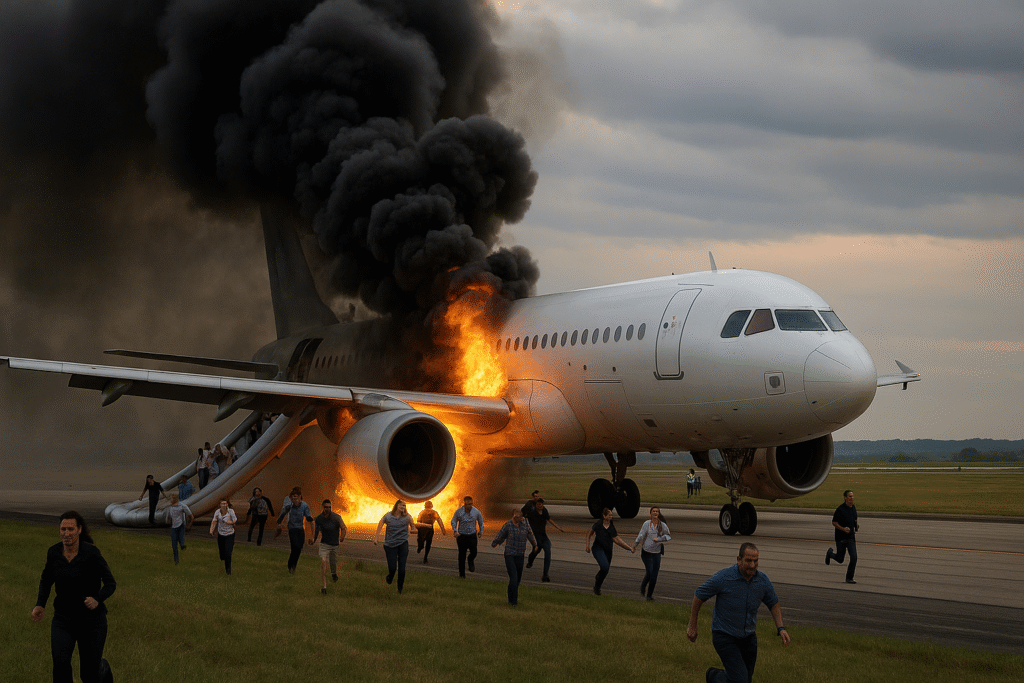On July 26, 2025, American Airlines Flight 3023, a Boeing 737 MAX 8 bound for Miami, aborted takeoff due to fire, smoke on runway before takeoff at Denver International Airport. The rear-left landing gear tire malfunctioned, catching fire and producing thick black smoke visible outside the cabin, prompting crew to initiate an emergency evacuation via inflatable slides.
All 173 passengers and 6 crew members evacuated safely; one person suffered a minor injury and was hospitalized. The Denver Fire Department extinguished the blaze by approximately 5:10 p.m. local time, and the aircraft was grounded for inspection. The FAA has launched an investigation.
Stunning Video Documents Fear and Accuracy
As smoke and flames swirl around the aircraft, frightened passengers can be seen sliding down emergency exits in video footage that has gone viral. Flight 3023, you got a lot of smoke, the ATC audio disclosed. Real-time drama is increased by saying, “You are actually on fire.” Passenger safety was guaranteed by the crew’s composed professionalism in spite of the obvious fire and smoke on the runway prior to takeoff.
Expert Analysis: Why It Matters
Aviation safety experts emphasize that incidents involving fire, smoke on the runway before takeoff — especially caused by landing gear tire failures — though rare, underline key areas for procedural review:
• Rigorous tire inspection protocols
• Enhanced pre-flight visual and sensor-based fire detection
• Training for rapid evacuation under panic scenarios
American Airlines has stressed its commitment to maintenance checks, stating the aircraft is removed from service to undergo a thorough inspection. The airline further extended apologies and arranged alternative travel for affected passengers.
FAA Reaction & Continued Examination
The FAA acknowledged that it is looking into the cause of the incident and characterized it as a possible landing gear incident. A number of incoming flights were delayed or diverted, and operations at Denver International Airport momentarily stopped. Before boarding a substitute plane to Miami, all passengers were subsequently driven to the terminal.
Conclusion: Insights from the Denver Runway Disaster
The incident that occurred at Denver International Airport today—fire and smoke on the runway prior to takeoff—highlights the dangers of flying as well as the dependability of safety systems when they are implemented correctly. Tragedy was averted by the prompt, well-planned evacuation, which demonstrated preparation and cooperation under duress.
For airline and airport officials alike, this incident is a potent reminder going forward of the value of strict maintenance, cutting-edge detection technology, and frequent emergency drills.
Frequently Asked Questions
Q1: What caused the smoke and fire prior to takeoff?
Ans. A malfunctioning landing gear tire caused smoke and fire on the runway prior to takeoff, resulting in a maintenance emergency and evacuation.
Q2: Were there any injuries from the incident?
Ans. There were no fatalities and only one passenger was admitted to the hospital with minor injuries.
Q3: Is flying generally still safe?
Ans. Yes, although terrifying, these kinds of events are very uncommon. Effective safety procedures, not a systemic failure, are reflected in the crew’s quick evacuation and response.
Q4: What actions are being taken in the wake of the incident?
Ans. The FAA is looking into the incident, the impacted aircraft was taken out of service for inspection, and later that day, passengers were transferred to another aircraft.



